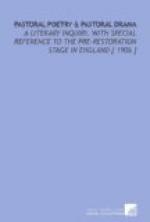The grandeur of the Roman Empire, the background against which in historical retrospect we see the bucolic eclogues of Vergil and his immediate followers, had vanished when Italian literature once more rose out of chaos. The political organism had resolved itself into its constituent elements, and fresh combinations had arisen. Nevertheless, though the Empire was hardly now the shadow of its pristine greatness, men still looked to Rome as the centre of the civilized world. As the seat of the Church, it stood for the one force capable of supplying a permanent element among the warring interests of European politics. Nothing was more natural than that the poetic form that had reflected the glories of imperial Rome should bow to the fascination of Rome, the visible emblem on earth of the spiritual empire of Christ. To the medieval mind, so far from there being any antagonism between the two ideas, the one seemed almost to involve and necessitate the other. It saw in the splendeur of the Empire the herald of a glory not of this world, a preparation as it were, a decking of the chamber against the advent of the bride; and thus the pastoral which sang of the greatness of pagan Rome appeared at the same time a hymn prophetic of the glory of the Church[23].
Moreover, during the centuries that had elapsed since the days of Vergil the term ‘pastoral’ had gained a new meaning and new associations. In the days of Augustus Pan was a boorish anachronism; it was left to medieval Christianity to create a god who was in fact a shepherd of men[24] and so to render possible a pastoral allegory that should embody the dearest hopes and aspirations of the human heart. That Christian pastoralists availed themselves successfully of the possibilities of the theme it would be difficult to maintain. It is a singular fact that, at a time when allegory was the characteristic literary form, it was yet so impossible even for the finer spirits to follow a train of thought clearly and consistently, that it was only when a mind passed beyond the limitations of its own age, and assumed a position sub specie aeternitatis, that it was able to free itself from the prevalent confusion of the imaginary and the real, the word and the idea, and to perceive that success in allegory depends, not on the chaotic intermingling of the attributes of the type and the thing typified, but on so representing the one as to suggest and illuminate the other.
In the early days of renascent humanism, the first to renew the pastoral tradition, broken for some ten centuries, was Francesco Petrarca. It is not without significance that the first modern eclogues were from the same pen as the sonnet ‘Fontana di dolore, albergo d’ira,’ expressive of the shame with which earnest sons of the Church contemplated the captivity of the holy father at Avignon; for thus on the very threshold of Arcadia we are met with those bitter denunciations of ecclesiastical corruption which




